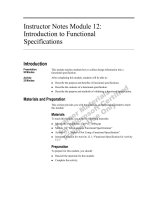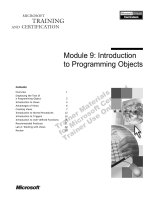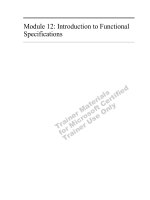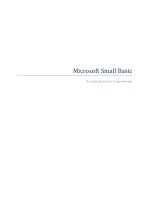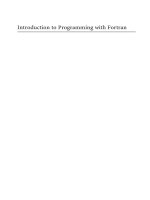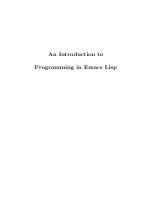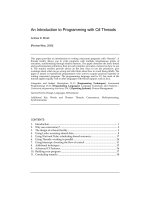Session 12 Introduction to Programming
Bạn đang xem bản rút gọn của tài liệu. Xem và tải ngay bản đầy đủ của tài liệu tại đây (154.32 KB, 28 trang )
LBC, Session 12
File Handling
FPT APTECH COMPUTER EDUCATION HANOI
Objectives
•
Explain streams and files
•
Discuss text streams and binary streams
•
Explain the various file functions
•
Explain file pointer
•
Discuss current active pointer
•
Explain command-line arguments
LBC/Session 12
2
File Input/Output
• All I/O operations in C are carried out using
functions from the standard library
• This approach makes the C file system very
powerful and flexible
• I/O in C is unique because data may be
transferred in its internal binary representation
or in a human-readable text format
LBC/Session 12
3
Streams
• The C file system works with a wide variety of devices
including printers, disk drives, tape drives and terminals
• Though all these devices are very different from each
other, the buffered file system transforms each device
into a logical device called a stream
• Since all streams act similarly, it is easy to handle the
different devices
• There are two types of streams - the text and binary
streams
LBC/Session 12
4
Text Streams
• A text stream is a sequence of characters that can be
organized into lines terminated by a new line character
• In a text stream, certain character translations may occur as
required by the environment
• Therefore, there may not be a one-to-one relationship between
the characters that are written (or read) and those in the
external device
• Also, because of possible translations, the number of
characters written (or read) may not be the same as those in
the external device
LBC/Session 12
5
Binary Streams
• A binary stream is a sequence of bytes with a one-to-one
correspondence to those in the external device, that is,
there are no character translations
• The number of bytes written (or read) is the same as the
number on the external device
• Binary streams are a flat sequence of bytes, which do not
have any flags to indicate the end of file or end of record
• The end of file is determined by the size of the file
LBC/Session 12
6
Files
• A file can refer to anything from a disk file to a terminal or
a printer
• A file is associated with a stream by performing an open
operation and disassociated by a close operation
• When a program terminates normally, all files are
automatically closed
• When a program crashes, the files remain open
LBC/Session 12
7
Basic File Functions
Name
Function
fopen( )
Opens a file
fclose( )
Closes a file
fputc( )
Writes a character to a file
fgetc( )
Reads a character from a file
fread()
Reads from a file to a buffer
fwrite()
Writes from a buffer to a file
fseek( )
Seeks a specific location in the file
fprintf( )
Operates like printf(), but on a file
fscanf( )
Operates like scanf(), but on a file
feof( )
Returns true if end-of-file is reached
ferror( )
Returns true if an error has occurred
rewind( )
Resets the file position locator to the beginning of the file
remove( )
Erases a file
fflush( )
Writes data from internal buffers to a specified file
LBC/Session 12
8
File Pointer
• A file pointer is essential for reading or writing files
• It is a pointer to a structure that contains the file name,
current position of the file, whether the file is being read
or written, and whether any errors or the end of the file
have occurred
• The definitions obtained from stdio.h include a structure
declaration called FILE
• The only declaration needed for a file pointer is:
FILE *fp
LBC/Session 12
9
Opening a Text File
•
The fopen() function opens a stream for use and links a file with that
stream
•
The fopen() function returns a file pointer associated with the file
•
The prototype for the fopen() function is:
FILE *fopen(const char *filename, const char
Mode
*mode);
Meaning
r
Open a text file for reading
w
Create a text file for writing
a
Append to a text file
r+
Open a text file for read/write
w+
Create a text file for read/write
a+f
Append or create a text file for read/write
LBC/Session 12
10
Closing a Text File
• It is important to close a file once it has been used
• This frees system resources and reduces the risk of
overshooting the limit of files that can be open
• Closing a stream flushes out any associated buffer, an
important operation that prevents loss of data when writing to
a disk
• The fclose() function closes a stream that was opened by a
call to fopen()
• The prototype for fclose() is:
int fclose(FILE *fp);
• The fcloseall() function closes all open streams
LBC/Session 12
11
Writing a Character – Text File
• Streams can be written to either character by
character or as strings
• The fputc() function is used for writing
characters to a file previously opened by fopen()
• The prototype is:
int fputc(int ch, FILE *fp);
LBC/Session 12
12
Reading a Character – Text File
• The fgetc() function is used for reading
characters from a file opened in read mode,
using fopen()
• The prototype is:
int fgetc(FILE *fp);
• The fgetc() function returns the next character
from the current position in the input stream, and
increments the file position indicator
LBC/Session 12
13
String l/O
• The functions fputs() and fgets() write and read character
strings to and from a disk file
• The fputs() function writes the entire string to the
specified stream
• The fgets() function reads a string from the specified
stream until either a new line character is read or length1 characters have been read
• The prototypes are:
int fputs(const char *str, FILE *fp);
char *fgets( char *str, int length, FILE *fp);
LBC/Session 12
14
Opening a File-Binary
•
The fopen() function opens a stream for use and links a file with that
stream
•
The fopen() function returns a file pointer associated with the file
•
The prototype for the fopen() function is:
FILE *fopen(const char *filename, const char
Mode
*mode);
Meaning
rb
Open a binary file for reading
wb
Create a binary file for writing
ab
Append to a binary file
r+b
Open a binary file for read/write
w+b
Create a binary file for read/write
a+b
Append a binary file for read/write
LBC/Session 12
15
Closing a File Binary
• The fclose() function closes a stream that was
opened by a call to fopen()
• The prototype for fclose() is:
int
fclose(FILE *fp);
LBC/Session 12
16
The fread() and fwrite() functions
•
The functions fread() and fwrite() are referred to as unformatted read or
write functions
•
They are used to read and write an entire block of data to and from a
file
•
The most useful application involves reading and writing user-defined
data types, especially structures
•
The prototypes for the functions are:
size_t fread(void *buffer, size_t num_bytes,
size_t count, FILE *fp);
size_t fwrite(const void *buffer,
size_t num_bytes, size_t count, FILE *fp);
LBC/Session 12
17
Using feof()
• The function feof() returns true if the end of the
file has been reached, otherwise it returns false
(0)
• This function is used while reading binary data
• The prototype is:
int feof (FILE *fp);
LBC/Session 12
18
The rewind() function
• The rewind() function resets the file position
indicator to the beginning of the file
• It takes the file pointer as its argument
• Syntax:
rewind(fp );
LBC/Session 12
19
The ferror() function
• The ferror() function determines whether a file
operation has produced an error
• As each operation sets the error condition,
ferror() should be called immediately after each
operation; otherwise, an error may be lost
• Its prototype is:
int ferror(FILE *fp);
LBC/Session 12
20
Erasing Files
• The remove() function erases a specified file
• Its prototype is:
int remove(char *filename);
LBC/Session 12
21
Flushing streams
•
The fflush() function flushes out the buffer depending
upon the file type
•
A file opened for read will have its input buffer cleared,
while a file opened for write will have its output buffer
written to the files
•
Its prototype is:
int fflush(FILE *fp);
•
The fflush() function, with a null, flushes all files opened
for output
LBC/Session 12
22
The Standard Streams
Whenever a C program starts execution under DOS, five
special streams are opened automatically by the operating
system
The standard input (stdin)
The standard output (stdout)
The standard error (stderr)
The standard printer (stdprn)
The standard auxiliary (stdaux)
LBC/Session 12
23
Current Active Pointer
•
A pointer is maintained in the FILE structure to keep
track of the position where I/O operations take place
•
Whenever a character is read from or written to the
stream, the current active pointer (known as curp) is
advanced
•
The current location of the current active pointer can be
found with the help of the ftell() function
•
The prototype is:
long int ftell(FILE *fp);
LBC/Session 12
24
Setting Current Position-1
•
The fseek() function repositions the curp by the specified
number bytes from the start, the current position or the
end of the stream depending upon the position specified
in the fseek() function
•
The prototype is:
int fseek (FILE *fp, long int offset, int origin);
LBC/Session 12
25
